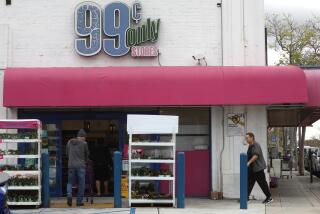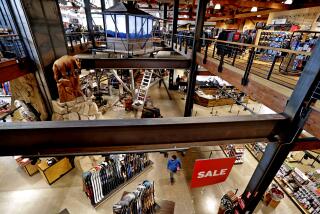GapShoes Gets Foot in Door in Costa Mesa : Retailing: Specialty retail chain extends its reach into the footwear market by setting up shop in South Coast Plaza.
- Share via
In the beginning was The Gap, a retail chain that carved its niche by selling sturdy casual clothing and accessories. The Gap’s success begat GapKids, which now incorporates the hot-selling BabyGap line.
With today’s opening of GapShoes at South Coast Plaza, the specialty retail chain is extending its reach into the hotly competitive footwear market. The Costa Mesa store is GapShoes’ first location in Southern California, its eighth nationwide.
The first GapShoes opened in August, 1992, in a Chicago suburb, offering a line of casual footwear that includes hiking boots, flats, sandals and canvas sneakers. GapShoes prices range from $24.50 to $140 a pair.
GapShoes is an example of a retail chain expanding through “a retail concept that basically builds upon its good name,” said Tony Cherbak, a Costa Mesa-based partner with the national accounting firm Deloitte & Touche. “It’s not as much a product extension as it is piggybacking on their good name.”
For example, Bullock’s opened Bullock’s Men Stores, the Foot Locker chain spun off Lady Foot Locker, and Nordstrom added its Nordstrom Rack locations. GapShoes is The Gap’s fourth free-standing store at South Coast Plaza, joining The Gap, GapKids and Banana Republic stores.
GapShoes is entering the footwear industry “at a challenging time,” said a spokeswoman for the Maryland-based National Shoe Retailers Assn., which represents independent shoe stores. Profit margins are tight, she said, because shoe stores face increased competition from “the deep discounters like Wal-Mart and the department stores that are buying in mass volume.”
South Coast Plaza and adjacent Crystal Court offer evidence of just how crowded the field is: More than 40 specialty and department stores in the two malls now sell various styles of footwear.
The Gap, based in San Francisco, moved into footwear as part of a companywide attempt to fend off increased competition from high-fashion and low-end retailers in the casual clothing market. The company’s strategy has been to bolster its basic line of casual shirts and jeans with new offerings, including intimate apparel, plaid blazers and a wider array of accessories.
“They’re taking the customer and servicing . . . (him or her) from head to toe,” said Bill Seitchik, vice president of a Bay Area executive search firm that specializes in the fashion and retail trades.
The Gap views footwear as a logical extension because, “if someone’s comfortable in the style The Gap has developed, they might be comfortable in the footwear as well,” said Steve Marotta, a retail industry analyst with the brokerage Johnson Redbook Service in New York.
The Gap’s chances of success in the crowded shoe market are good because “this is the company that reinvented how specialty (clothing) stores display merchandise,” Marotta said. “I wouldn’t be surprised if they’re able to do the same thing with shoes.”
During 1992, The Gap passed Liz Claiborne to become the nation’s second-largest clothing label after Levi Srauss. The company operates 797 Gap stores, 254 GapKids and 163 Banana Republics. It reported a $230-million profit for fiscal 1991 on revenue of $2.5 billion.
Despite its successes, The Gap has stumbled on Wall Street. Its stock hit a high of $59.125 a share in January, 1992, but then tumbled to the mid-$30s. In Wednesday’s trading on the New York Stock Exchange, the stock closed at $35.375 a share, down 50 cents. Stock analysts have linked the company’s weak market performance to increased competition that has slowed earnings increases and moderated its dramatic growth.
More to Read
Inside the business of entertainment
The Wide Shot brings you news, analysis and insights on everything from streaming wars to production — and what it all means for the future.
You may occasionally receive promotional content from the Los Angeles Times.










